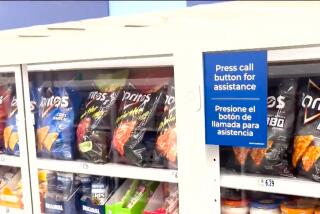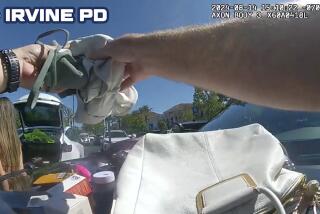‘Tis a Busy Time for the Takers, Too
The guy in the striped shirt kept looking around as he tried on a sweater in the men’s department of the Broadway. All that craning caught the attention of the store’s security chief and, in the camera room two floors up, she zoomed in on him with two of her closed-circuit TV cameras.
As loss prevention manager, Rose Culp has spent most of the holiday season spying on customers from her bank of 21 closed-circuit TV monitors. With a flick of her hand, she can zoom in on customers so close that she can tell what kind of earrings the shopper is wearing or what style socks he has on.
The cameras are hidden within glittering domes throughout the store.
Most of the people Culp watches are typical Christmas shoppers, browsing and buying. But some are scoping out the territory to see what they can steal. And, like the honest customers rushing through the busiest shopping season of the year, shoplifters are out in force during the busiest shoplifting season of the year.
Sometimes called the five-finger discount, shoplifting will account for nearly 2 million arrests nationwide this year. In Orange County, it was the only petty theft that increased last year. Shoplifting arrests increased 15% from 1985 to 1987 and last year’s estimated value of stolen goods in the county was $1,433,913. Retailers estimate that nationally about $30 billion is lost to shoplifters annually.
During a normal month, about five to 10 shoplifters are apprehended at most Broadway stores, but during the holidays, the number more than doubles, according to David Simon, regional loss prevention manager for the department store chain.
But that doesn’t mean people are any more dishonest at Christmas or that more people are getting into thievery. It just means there are more people in the stores. And as Orange County grows, so does its shoplifting problem.
“Yes, there is more shoplifting in Orange County today than there was 10 years ago, but there’s also about 10 times more people,” says Edward A. Wolfe, vice president of loss prevention for Carter Hawley Hale Stores, parent company of the Broadway. “I don’t think per capita it’s necessarily increasing.”
Security experts caution that shoplifting statistics don’t mean very much because they are based on the number of apprehensions made, and the number of apprehensions doesn’t usually reflect the number of thefts committed. In fact, most shoplifters get away with it. Experts estimate that for every arrest, 35 more scram with the loot.
“What all retailers dream about is one sure method of deterring shoplifting,” says Roger Griffin, who surveys store theft throughout Southern California for Commercial Service Systems in Van Nuys. “But there isn’t any. How many times have you had trouble finding a salesclerk to help you with a legitimate purchase? No community can afford the number of sworn police officers it needs (to keep it crime-free). The same is true of retailers.”
Wolfe agrees. “You know what it’s like. You go into a store looking for a wrench. You can’t find the wrench or anybody to help you find it. If nobody is there to help, most likely nobody is there to stop you from shoplifting either,” he said.
Along with the most frequent method of shoplifting--slipping something into a pocket or purse--”professional” thieves use the grab-and-run approach: Merchandise displayed near the store entrances is snatched and rushed out of the vicinity, usually with the help of an accomplice-driven car.
Around the holidays, police see more professional techniques, such as “booster boxes” that can be purchased at novelty stores for $50. Hollow boxes usually wrapped like a present, booster boxes have spring-released trap doors for hidden merchandise and are particularly prevalent during the Christmas season, says Tim Schennum, one of three Costa Mesa police officers assigned to the department’s substation at South Coast Plaza.
Another technique favored by the pros is refunding, a practice rampant right after Christmas. Refunding, perhaps the easiest theft to commit and the hardest to thwart, doesn’t require hiding merchandise or leaving the store. The thief simply takes an expensive item off the shelf and brings it to the salesclerk, saying it’s an unwanted gift or that it doesn’t fit. If the store doesn’t give cash refunds without a receipt but instead issues credit, the shoplifter buys an item with the credit slip, thereby obtaining a legitimate sales receipt, and returns the item at a different store branch for cash.
“What are you going to do if a guy picks up something on a rack and takes it over to the cash register?” Simon asked. “Unless he is seen removing the item from display and trying to conceal it, he’s a hard one to catch.”
But most shoplifters are amateurs: teachers, welders, attorneys, students--in many ways average people who think they can get away with it. Aside from the fact that the majority of shoplifters apprehended are women between the ages of 18 and 35, experts can’t paint a profile of the typical shoplifter. The crime crosses all ethnic and socioeconomic lines. Last May’s arrest of former Miss America Bess Myerson for shoplifting $44 worth of costume jewelry and makeup highlighted a problem that most stores and thieves won’t talk about. Stealing by people who can afford to pay happens in every community, rich or poor.
“It’s the exception when someone doesn’t have the money to pay for the items,” Griffin said. “They’re not desperate people stealing out of need.”
The average value of the stolen loot is $11 if taken at a grocery store, or $100 if lifted from a department store. The most commonly stolen items are meat, cigarettes and vitamins at grocery stores and jewelry and accessories at department stores.
Why would an “average” person steal $11 worth of lamb chops if he or she could afford to buy it?
“My own theory is that it’s a combination of a very low temptation threshold and a lot of temptation,” Griffin said. “When you put that many people in self-serve stores where the retailing philosophy is to make the merchandise as tempting as possible, it’s simply too hard for some people to resist.”
Orange County shoplifters are like shoplifters anywhere, experts agree. But they may take more expensive merchandise.
“The merchandise carried in Orange County stores tends to be more expensive, and the tendency (among shoplifters) is to take the more expensive items,” Wolfe said. “It comes down to the style of merchandise; they’ll always take the better items in any given store.”
Simon pointed out that the “grab-and-run” technique is tried more often in poorer urban areas whereas Orange County shoplifters are more apt to hide an article in a purse or under a shirt.
Estimates on how much is stolen vary from retailer to retailer, but Griffin says the total amount of merchandise taken by shoplifters or employees is probably about 2% of total sales at most stores. This figure, called “inventory shrink,” includes the bills that don’t get deposited into the cash register by salesclerks, or the merchandise stolen by a stock boy, or the amount lost to shoppers switching price tags on goods, as well as the total taken by shoplifters. No one knows how much is lost by which method.
“An educated guess is about the best anyone can do in estimating shoplifting losses,” he said. “But they can really be substantial. One of the interesting things is the retailers never give any publicity to their losses. I guess every retailer wants the best possible environment for the shoppers; they want the best feelings promoted. They don’t want it to look like the place is frequented by thieves or that their employees are thieves. And many don’t want their shareholders to think that.”
Although most retailers refuse to discuss their security programs, the Broadway wants the public to know that its stores are on the lookout for thieves. Management hopes the information will serve as a deterrent and not disturb its paying customers.
“It’s a fine line to (monitor) the less than 1% of your customers who are not good people and the rest, who are honest shoppers,” said Bill Dombrowski, vice president of corporate affairs for Carter Hawley Hale.
Many large store chains, including Sears and Bullock’s, have installed computer-operated closed-circuit television monitors like the Broadway’s. But the cost, between $50,000 and $70,000 depending on the size of the system, has prevented others from adopting it. Other security techniques--including stationing detectives inside pillars with one-way mirrors, or attaching to merchandise tags that set off alarms, or rewarding employees who report stealing--are also part of the anti-theft arsenal.
Every major department store at South Coast Plaza has its own security agents, according to Costa Mesa police. Many stores have electronic article-surveillance tags, those hard plastic clips designed to set off an alarm when taken through the electronic field at the store’s entrance. And many grocery stores are placing similar tiny electronic labels on merchandise.
“We prefer not to discuss our security methods with the press,” says Jack McCarley, vice president of corporate affairs for Bullock’s. McCarley did confirm, however, that Bullock’s uses closed-circuit TV monitors and electronic article-surveillance tags.
The May Co. and the Broadway also have programs that reward employees who report stealing in the stores, either by shoplifters or other employees.
According to Griffin, alert salesclerks and the article-surveillance tags are among the best deterrents. They both can physically prevent shoplifters from leaving the store with the merchandise--the clerks by assisting the “customers” so much they wouldn’t have an opportunity to steal and the tags by setting off an alarm so clerks can recover the merchandise.
And given the difficulties retailers have in prosecuting shoplifters, prevention is given high priority.
“We have become much more assertive in preventing shoplifting.” said Wolfe at Carter Hawley Hale. “The principle weapon against shoplifting is good customer service. The first thing we want to do is approach each customer, to help them select the merchandise. But the side benefit is the customer knows we’re there, watching and helping in every way.”
To apprehend a shoplifter, a store employee has to see the person take the merchandise off the shelf, try to conceal it and take it out of the store. If the agent blinks, sneezes, looks away or is distracted, he probably won’t be able to track the activity enough to apprehend.
Griffin stresses that shoplifting is a crime of intent, and if the retailer can’t prove the person intended to steal, the case won’t hold and leaves the store open to charges of false arrest. These difficulties in prosecuting discourage some stores from calling the police to arrest those apprehended.
“How do you know if they intended to steal?” he says. “What if they say, ‘Oh, I forgot I had it in my hand’?”
Witnesses need to see such key gestures as furtive glancing and attempts to conceal merchandise to make a case stick.
“Prosecution doesn’t happen a lot because so much effort is made to avoid” shoplifting, Griffin said. “Only a fraction of shoplifters are turned over to police. The courts would be inundated if they all were.”
Schennum says that usually first-time offenders are released after arrest, but that they have to appear in court and pay a fine determined by the judge. No jail time is served.
“They’re a little more lenient with first-time offenders; they don’t usually starting cracking down until they’ve been arrested four or five times,” he said.
“I have great admiration for retailers who prosecute,” said Griffin. “Retailers’ exposure to civil liability is very great.”
Meanwhile, the young man in the striped sweater has examined a few more items and seems to take particular interest in those without surveillance tags. Now he is moving around the department and Culp is tapping the computer button to keep the camera trained on him. But at one point he slips behind a pillar, where the camera can’t reach. Culp says its one of the few spots in the store the camera can’t go.
Soon, the man reappears and loses interest in the sweaters. Now Culp decides she’s wrong; he is not acting suspiciously but rather passing time in the men’s department while he’s waiting for someone. What had looked like furtive glances had probably just been the man’s custom of looking around when he’s in public.
With another flick of her wrist, she switches to jewelry, where a woman keeps handling the same piece over and over. She looks like she really wants it. But no, she leaves it on the counter and walks out of the store.
It’s a slow day for security.
More to Read
Sign up for Essential California
The most important California stories and recommendations in your inbox every morning.
You may occasionally receive promotional content from the Los Angeles Times.










